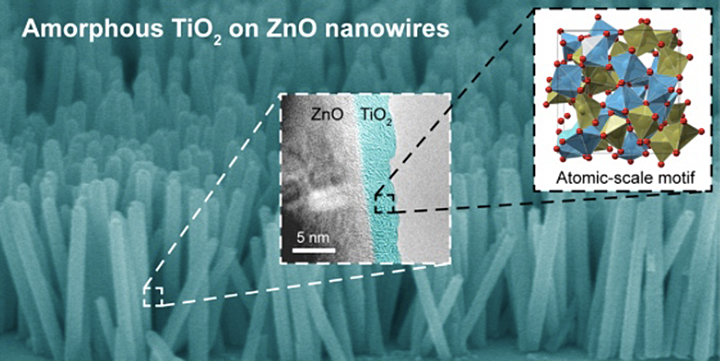Optimizing the Growth of Coatings on Nanowire Catalysts
Scientists chemically treated the surface of wire-looking nanostructures made of zinc oxide to apply a uniform coating of titanium dioxide; these semiconducting nanowires could be used as high-activity catalysts for solar fuel production
July 31, 2019

The background shows a scanning electron microscope image of the titania-coated nanowires, while the foreground shows a high-resolution transmission electron microscope image that distinguishes between the ZnO core, the titania shell, and the atomic-scale motif of the shell.
The Science
Scientists demonstrated a new optimal path to grow titania layers on zinc oxide (ZnO) nanowires, which can be used as catalysts.
The Impact
These results have the potential to improve solar cell efficiency and could be transferred to other applications in energy storage that use similar catalysts.
Summary
Solar energy harvested by semiconductors can trigger surface electrochemical reactions that generate clean and sustainable fuels, such as hydrogen. Highly stable and active catalysts are needed to accelerate these reactions; however, because of photocorrosion, many of these catalysts lose their activity for the water-splitting reaction.
Now, a team of scientists has come up with a technique for optimizing the activity of one such catalyst: 500-nanometer-long but relatively thin (40 to 50 nanometers wide) nanostructures, or nanowires, made of zinc oxide (ZnO). Their technique involves chemically treating the surface of the nanowires in such a way that they can be uniformly coated with an ultrathin (two to three nanometers thick) film of titanium dioxide (titania), which acts as both a catalyst and a protective layer. The scientists used multiple techniques at the Center for Functional Nanomaterials (CFN)—a U.S. Department of Energy (DOE) Office of Science User Facility at DOE’s Brookhaven National Laboratory—to create a uniform titania coating on the nanowires. In this study, they found that low-pressure plasma sputtering, among other steps, achieves the most uniform results. To fully characterize the wires, the scientists used transmission electron microscopy and x-ray absorption spectroscopy at the Inner-Shell Spectroscopy (ISS) and In situ and Operando Soft X-ray Spectroscopy (IOS) beamlines of the National Synchrotron Light Source II (NSLS-II)—another DOE Office of Science User Facility located at Brookhaven Lab.
These results were then compared with first principle calculations at Brookhaven’s Computational Science Initiative and the National Energy Research Scientific Computing Center, a DOE Office of Science User Facility operated by Lawrence Berkeley National Laboratory. The results of both theoretical calculations and experimental measurements suggest that the titania shell contains a substantial fraction of Ti4+ ions, indicating the titanium atoms were undercoordinated.
Next, the team will extend their approach of combining experimental and theoretical spectroscopy data analyses to materials relevant to quantum information science (QIS).
Download the research summary slide
Related Links
Feature Story: “Optimizing the Growth of Coatings on Nanowire Catalysts”
Contact
Deyu Lu
Brookhaven National Laboratory
dlu@bnl.gov
Mingzhao Liu
Brookhaven National Laboratory
mzliu@bnl.gov
Publications
D. Yan, M. Topsakal, S. Selcuk, J. L. Lyons, W. Zhang, Q. Wu, I. Waluyo, E. Stavitski, K. Attenkofer, S. Yoo, M. S. Hybertsen, D. Lu, D. J. Stacchiola, and M. Liu, “Ultrathin Amorphous Titania on Nanowires: Optimization of Conformal Growth and Elucidation of Atomic-Scale Motifs”, ACS Nano Lett. 19:6, 3457-3463 (2019). DOI: 10.1021/acs.nanolett.8b04888
Funding
This research was carried out at Brookhaven National Laboratory (BNL) under contract no. DE-SC0012704, where facilities used included those of the Center for Functional Nanomaterials (CFN) and the beamlines 8-ID ISS (Inner Shell Spectroscopy) and 23-ID-2 in situ and operando soft x-ray spectroscopy (IOS) in the National Synchrotron Light Source II, U.S. Department of Energy Office of Science User Facilities, and the Scientific Data and Computing Center, a component of the BNL Computational Science Initiative. This research also used resources of the National Energy Research Scientific Computing Center (NERSC), a U.S. Department of Energy Office of Science User Facility operated under contract no. DE-AC02-05CH11231. The effort on computation was supported by LDRD Project at BNL (no. 16-039). The additional support to this study came from the Office of Naval Research through the Naval Research Laboratory’s Basic Research Program.
2019-16727 | INT/EXT | Newsroom









